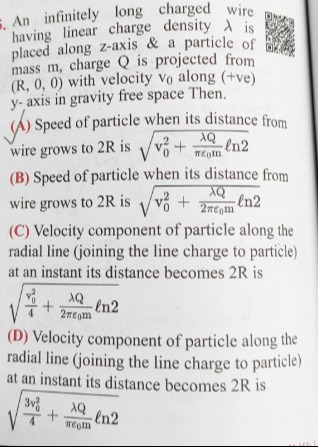Question
Question: An infinitely long charged wire having linear charge density $\lambda$ is placed along z-axis & a pa...
An infinitely long charged wire having linear charge density λ is placed along z-axis & a particle of mass m, charge Q is projected from (R, 0, 0) with velocity v0 along (+ve) y- axis in gravity free space Then.

Speed of particle when its distance from wire grows to 2R is v02+πϵ0mλQln2
Speed of particle when its distance from wire grows to 2R is v02+2πϵ0mλQln2
Velocity component of particle along the radial line (joining the line charge to particle) at an instant its distance becomes 2R is 4v02+2πϵ0mλQln2
Velocity component of particle along the radial line (joining the line charge to particle) at an instant its distance becomes 2R is 43v02+πϵ0mλQln2
(A), (D)
Solution
The electric field due to an infinitely long charged wire with linear charge density λ at a perpendicular distance r is given by E=2πϵ0rλr^, where r^ is the unit vector in the radial direction from the wire. The force on a particle with charge Q is F=QE=2πϵ0rQλr^. This force is conservative.
The initial position of the particle is (R,0,0), so the initial distance from the wire is ri=R. The initial velocity is v0=v0j^. The initial speed is v0. The motion is in the xy-plane since the initial velocity is in the xy-plane and the force is also in the xy-plane (radially outwards from the z-axis).
The potential energy of the particle at a distance r from the wire is given by U(r)=QV(r), where V(r) is the electric potential. The potential difference between two points at distances r1 and r2 is V(r2)−V(r1)=−∫r1r2E⋅dr=−∫r1r22πϵ0rλdr=−2πϵ0λln(r1r2)=2πϵ0λln(r2r1). The change in potential energy as the particle moves from ri to rf is ΔU=U(rf)−U(ri)=Q(V(rf)−V(ri))=2πϵ0Qλln(rfri).
By conservation of mechanical energy, ΔKE+ΔU=0, so ΔKE=−ΔU. KEf−KEi=−2πϵ0Qλln(rfri)=2πϵ0Qλln(rirf). The initial kinetic energy is KEi=21mv02. Let the speed of the particle when its distance from the wire is rf=2R be vf. The final kinetic energy is KEf=21mvf2. Substituting ri=R and rf=2R: 21mvf2−21mv02=2πϵ0Qλln(R2R)=2πϵ0Qλln(2). 21mvf2=21mv02+2πϵ0Qλln(2). mvf2=mv02+πϵ0Qλln(2). vf2=v02+πϵ0mQλln(2). vf=v02+πϵ0mQλln(2). This matches option (A).
Now consider the velocity component along the radial line. The radial velocity component is vr=dtdr. The velocity vector in polar coordinates in the xy-plane is v=vrr^+vθθ^, where vθ=rdtdθ is the tangential velocity component. The force is purely radial, F=Frr^. There is no tangential force, Fθ=0. The angular momentum about the z-axis is conserved because the torque about the z-axis is zero: τ=r×F=rr^×Frr^=0. The angular momentum about the z-axis is Lz=mr2θ˙=mrvθ. Initial position is (R,0,0), so ri=R. Initial velocity is v0=v0j^. At the initial position (R,0), the radial direction is along the +x-axis (r^=i^) and the tangential direction is along the +y-axis (θ^=j^). So, initial velocity v0=v0j^=v0θ^i. Initial radial velocity vri=v0⋅r^i=v0j^⋅i^=0. Initial tangential velocity vθi=v0⋅θ^i=v0j^⋅j^=v0. The initial angular momentum about the z-axis is L_z_i = m r_i v_{\theta i} = m R v_0.
When the distance from the wire is rf=2R, let the tangential velocity component be vθf. By conservation of angular momentum about the z-axis: L_z_f = L_z_i mrfvθf=mRv0. m(2R)vθf=mRv0. 2vθf=v0⟹vθf=2v0.
The speed of the particle at rf=2R is vf. The speed is related to the radial and tangential velocity components by vf2=vrf2+vθf2. We found vf2=v02+πϵ0mQλln(2) and vθf=2v0. So, vf2=vrf2+(2v0)2=vrf2+4v02. Substitute the expression for vf2: v02+πϵ0mQλln(2)=vrf2+4v02. vrf2=v02−4v02+πϵ0mQλln(2). vrf2=43v02+πϵ0mQλln(2). The radial velocity component is vrf=43v02+πϵ0mQλln(2). This matches option (D).
